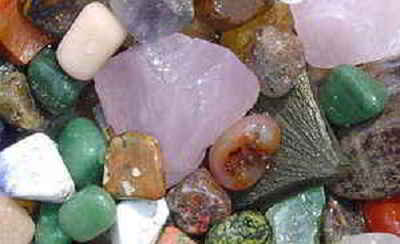Alaska State Gemstone or Gem
Jade

(Nephrite)
Adopted in 1968
Jade, (Nephrite,) was adopted by the Alaska Legislature in 1968 as the State Gem. Most deposits of Jade are found near the Kobuk River and Jade Mountain, also near the Dall and Shungnak rivers. This famous, remote, Arctic interior jade locality has an extensive history. Artifacts made from Kobuk River nephrite are hundreds of years old and have been found at archaeological sites along the Bering and Pacific coasts of Alaska and British Columbia, and the Arctic coast of Canada.
Jade: Alaska State Gemstone

US Navy lieutenant, George M. Stoney discovered the Kobuk River source
in 1886. This earned him the distinction of being the first non-Native to find nephrite in place in North America. From 1943 to 1945, the Alaska Territorial
Department of Mines investigated the deposit in an attempt to find asbestos for the war effort. In 1945, eleven tons of jade and some 200 tons of asbestos
were produced from the locality. Government geologists determined that the jade and asbestos at the locality occur in a 40-mile stretch of altered
ultra basic rocks consisting mainly of serpentine that extends north of, and roughly parallel to, the Kobuk River.
The quality of Alaskan nephrite is highly variable; the finest material is usually found in smooth, stream-rolled boulders such as the 10-pound example
featured here. Many of the boulders are covered by a thin rind of brown material, a result of weathering, which must be removed to reveal the unaltered
green nephrite beneath
The term JADE is a generic term that actually covers three minerals. They are Jadeite, Nephrite, and Chloromenlanite.
Jade is chiefly valued by it's color and freedom from cracks. It should have a 'greasy' appearance when it is polished. Colors will range from the
many shades of green, to yellow, red, black, and white. Lavender Jade is the most highly valued, and also the most rare forms of the stone.
Jadeite is composed mainly of silica and alumina, it's green color is determined by the amount of iron present. Jadeite is generally brighter and more
vivid in color than nephrite. It's body is more translucent and sometimes partially crystallized. The white variety of Jadeite with the brilliant streaks
of deep emerald green, gets it color from the element 'CHROMIUM'.
Nephrite is composed mainly of silica and magnesia, it is also dependent on its color by the amount of iron present. Nephrite is usually some shade
of green: it may range from sea green, gray green, celadon, lettuce green, grassy green, and spinach green. Other colors of nephrite include blue gray,
reddish gray, greenish gray, yellow, and black.
Chloromenlanite is a black variety of Jadeite, belonging to the same 'CLASS' which mostly is found in Burma. It was named by "DAMOUR" in 1865. Many
black carving from remote regions of China come under this classification of mineral. Silica, alumina, and soda, being equally prominent in Chloromenlanite
and Jadeite.
Jade Uses and Purposes

Jade is an ancient stone that has historically been used to attract love. Carved into a butterfly, in China it is a powerful symbol used to draw love.
Jade can be used to bring money into your life. Create a positive attitude towards money and visualize yourself using money creatively and productively while holding the stone in your power hand. When making an important business decision, use the prosperous energies of jade by holding it while contemplating your course of action. Jade strengthens your mental faculties and assists in clear reasoning.
Jade is also a protective stone, guarding against accidents and misfortune. Place a piece of jade between two purple candles and let the candles burn for a short while. Then carry the jade with you as a protection amulet.
Alaska Law
The law designating the jade as the official Alaska state gem is found in the Alaska Statutes 2015 TITLE 44. STATE GOVERNMENT Chapter 44.09 STATE SEAL, FLAG, AND EMBLEMS Sec. 44.09.100. State gem.
TITLE 44. STATE GOVERNMENT
Chapter 44.09 STATE SEAL, FLAG, AND EMBLEMS
Sec. 44.09.100. State gem.
Sec. 44.09.100. State gem.
Jade is the official state gem.
HISTORY
(Sec. 1 ch 51 SLA 1968)
Minerals, & Gems

Gemstone, Minerals, Rocks







